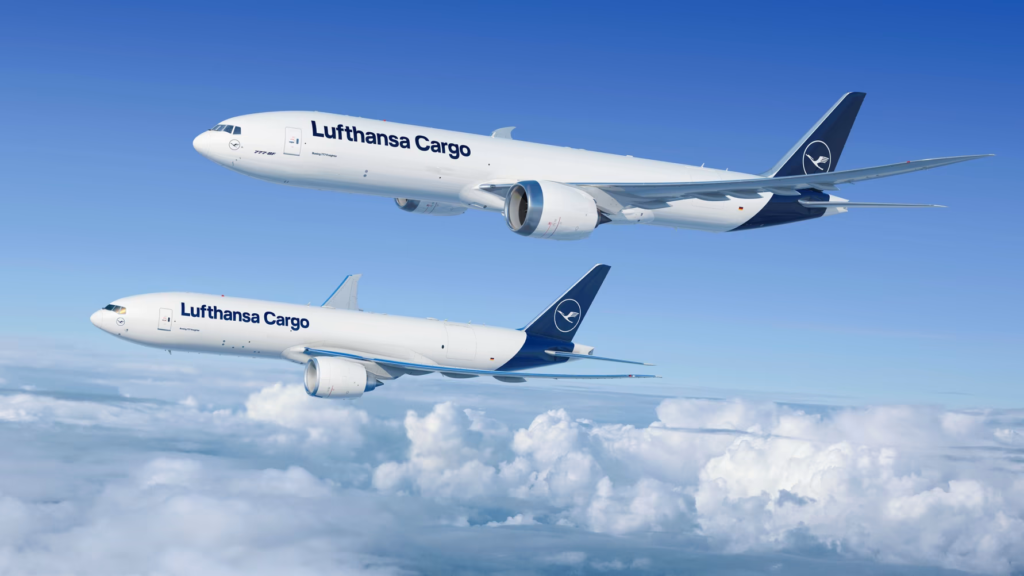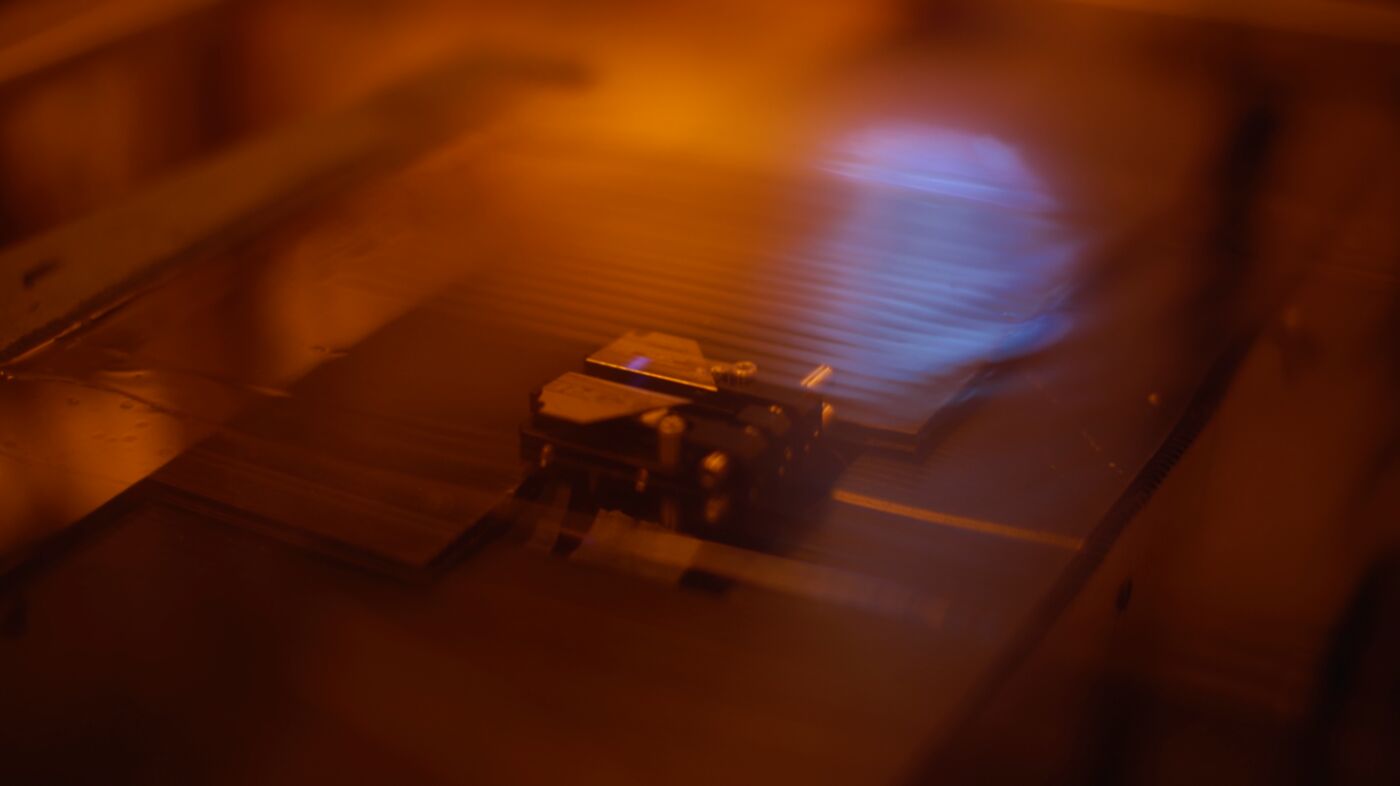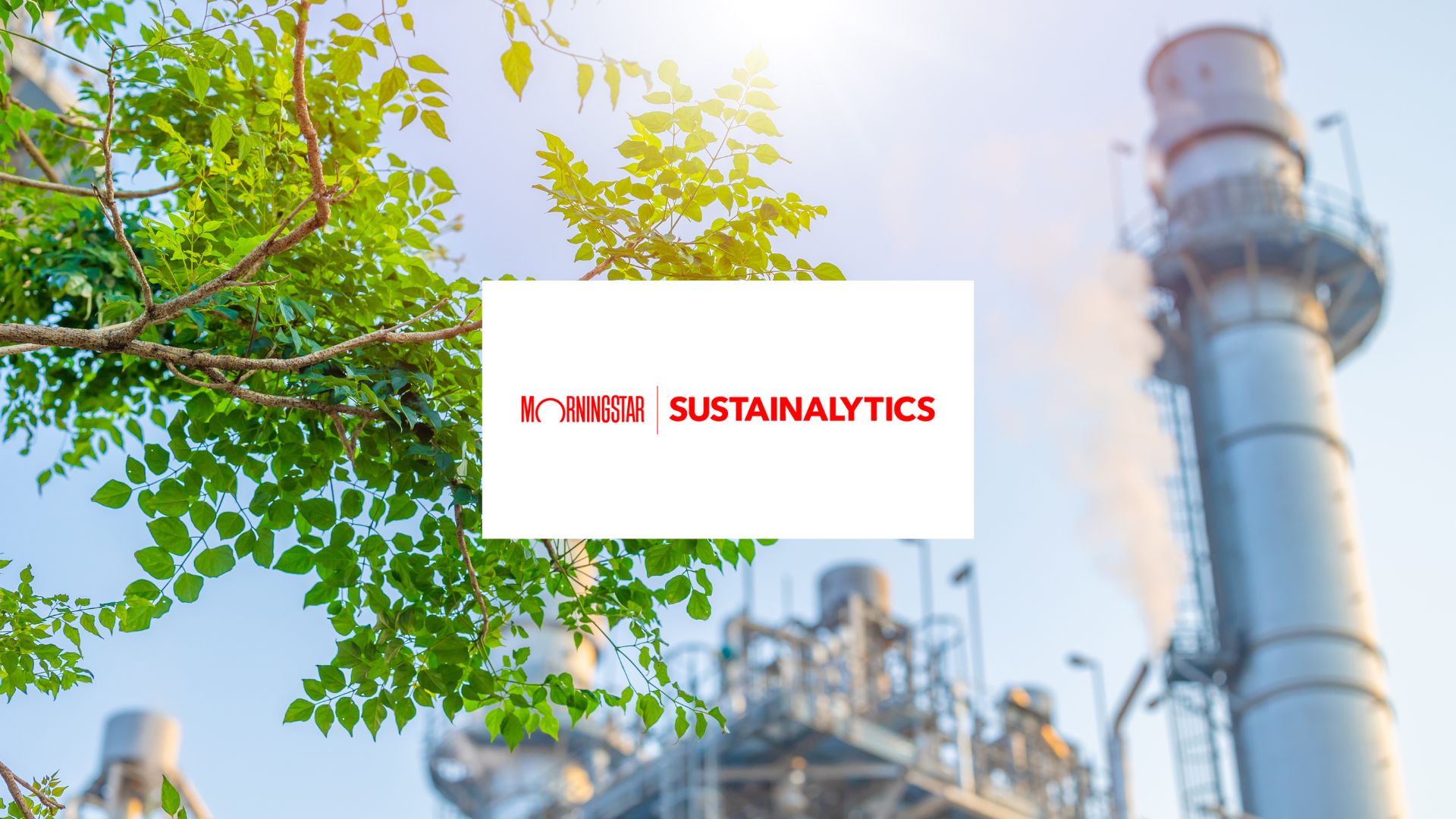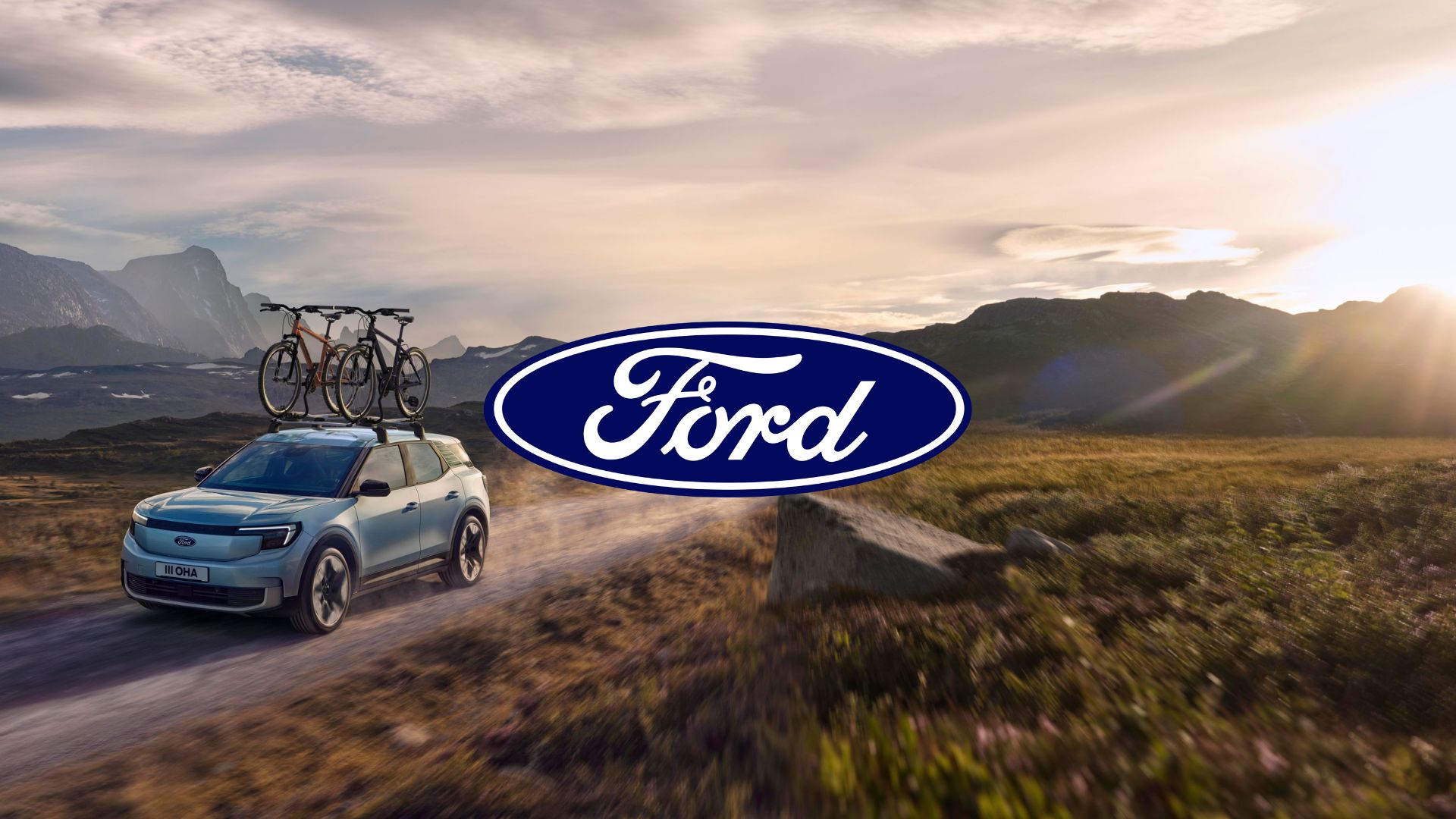Lufthansa Shark-Skin Technology Lets Planes Fly Fast With Less Fuel

- Lufthansa Technik has begun applying a film to reduce air drag
- Riblet drag reduction may be applied to wind turbines, ships
Earlier this year, a Lufthansa Group Boeing 747-400 flying on the carrier’s international route of networks in Asia sported an unusual covering on its underside. Attached to portions of the craft’s lower fuselage and belly fairing was a thin film-like coating imprinted with a ribbed texture of small protrusions, each about 50 micrometers high. The riblets on the surface of the film, dubbed AeroSHARK, are designed to reduce friction between the aircraft’s surface and the air around it in a bid to cut fuel consumption and lower carbon emissions.
The film, inspired by shark skin and its well-known ability to reduce drag in water, is a prime example of what’s known as biomimicry. But it’s more than that. AeroSHARK is also an example of the measures the airline industry is willing to take amid a heightened focus on the industry’s contributions to anthropogenic greenhouse-gases. Before the Covid-19 pandemic, traveling by air contributed about 2.5% of greenhouse gases. With travel bouncing back and the industry pledging to cut emissions to zero, the pressure is on to eke out any way possible to make flying greener.

For now, the industry is throwing much of its weight behind sustainable aviation fuel (SAF) to cut emissions. SAF is promising because it’s a cleaner alternative to fossil fuel and can essentially be used exactly the same as conventional fossil jet fuel, though producing enough of it will be a challenge. Battery electric planes are also under development, as are craft powered by compressed hydrogen. Both nascent technologies, however, are still some years in the future.
The future isn’t as far off as some would imagine. The 30-odd year lifespan of a typical airplane means models coming off the assembly line today will be flying well into the next couple of decades, running up against the industry’s commitment to wean its way off carbon by 2050. Given the strict regulations aircraft makers face when considering any change to the configuration of their craft, attempts to come up with more fuel-efficient models gets complicated.
All the more reason, many in the industry say, to introduce tweaks around the edges to shave off a bit of drag or make flying more efficient even with existing aircraft models. Within that equation, Lufthansa is optimistic innovations like AeroSHARK will fill a need not just for itself but for the industry more widely.
AeroSHARK was developed by Lufthansa Technik, a subsidiary of the Lufthansa Group, together with chemicals and coatings manufacturer BASF SE. Lufthansa Technik says patches of AeroSHARK applied to its Boeing 747-400 cuts friction with the air by about 0.8%, translating to 300 metric tons of fuel saved annually and a cut in CO2 emissions of more than 900 metric tons a year. While Lufthansa has been flying the 747-400 with AeroSHARK since late 2019, the Covid-19 pandemic temporarily grounded the craft. It returned to regular service in December 2021.
Lufthansa Technik says AeroSHARK is resilient, can withstand large temperature shifts, pressure differentials and the ultra violet radiation on high flight levels.
See related article: Delta, DG Fuels partner in pivotal expansion of sustainable fuel market
Drag reduction properties
“The beneficial properties of shark skin for reducing drag and providing the animal with more agility and more speed in the water have been known for some time,” said Michael Lagemann, a press spokesman at Lufthansa Technik. “Since then many people have been vocal about the idea of using this for technical applications and aircraft have been on the forefront of this.”
So far, the 500 square meters of AeroSHARK on the underbelly of that 747-400 represents the first step in what the carrier and its subsidiary hope will be a much grander adoption. Applied to 800 square meters of all 10 of its entire Boeing 777F freighter fleet, Lufthansa says the film could mean annual savings of about 3,700 metric tons of kerosene and slightly less than 11,700 tons of CO2 emissions, or the equivalent of 48 individual freight flights from Frankfurt to Shanghai.
“The theoretical maximum potential is in the vicinity of around 2 1/2 to 3 percent,” said Lagemann, referring to the potential drag reduction. “If you are able to modify all the surfaces of the aircraft, we would be at something like 4%. We’re not allowed to modify all surfaces though because there are areas where airflow is already quite good and there are certain areas, like in front of sensors, that are not allowed because they have perfectly defined airflow to guarantee correct measurements.”
Currently, Lufthansa Technik is working on certification for two types of Boeing 777s — the 777F for Lufthansa Cargo and the 777-300ER for Swiss International Air Lines AG. In February, SWISS said it would equip its entire Boeing long-haul fleet with AeroSHARK, becoming the first passenger airline in the world to use the skin technology. The carrier was to have begun gradually fitting 12 Boeing 777-300ERs with the riblet film in the middle of the year. The goal is to apply about 950 square meters of the film to each plane; SWISS says the potential for fuel and CO2 savings is about 1.1% at that level, which translates to 4,800 tons of fuel and 15,200 tons of carbon dioxide annually, or emissions equivalent to 87 long-haul flights from Zurich to Mumbai.
“We have seen a lot of customer interest,” Lufthansa Technik’s Lagemann said. “Our plan is to maximize the savings potential on a global scale to get as many airlines as possible on board and certify AeroSHARK for many more aircraft types.”
Improving an aircraft’s fuel efficiency is one of the cornerstones of efforts to cut operating costs and carbon intensity, BloombergNEF researchers said in a report on aircraft technology published in May. Advances in aerodynamics, aircraft structure and materials all promise to cut drag, lower the weight of airframes and generate lift with less energy expended. But while the introduction of new aircraft designs may result in further efficiency gains, that isn’t likely to come until sometime after 2035, meaning next-generation ultra-high bypass turbofans are likely to be key to reducing fuel burn, the report said.
“With no technical option available to reduce emissions from aviation at scale economically today, airlines in the world are taking a wide range of possible measures, from retirement of the old aircraft fleet, the launch of carbon offset programs for passengers, offtake of sustainable aviation fuel, to investments in startups working on hydrogen-powered propulsion technology,” BNEF aviation analyst Takehiro Kawahara said.
Aircraft fuel efficiency trends
“Historically, the lion’s share of the efficiency gains have been in the engine,” said Jayant Mukhopadhaya, a Berlin-based aviation researcher with the International Council on Clean Transportation. “They become bigger, you have higher bypass ratio. Basically, the engine is more efficient. The reason why it’s the engine and not the rest of the aircraft is because the aviation industry is pretty averse to making big changes in aircraft design.”
But engines have their limitations, especially as they get bigger, Mukhopadhaya said.
“The engines are gigantic now, so much so that it can sometimes cause problems in terms of aircraft clearance,” he said. “The quickest efficiency gains that you can see now are these things like AeroSHARK. I hadn’t heard of it until recently and I was surprised that it hasn’t gained more traction if it in fact does create the fuel efficiency gains that Lufthansa claims it does.”
Combined with measures such as artificial intelligence to optimize flight trajectories, efficient taxiing and electric tow trucks — in other words, steps that can be taken now without a wholesale redesign of an aircraft’s body or propulsion system — Mukhopadhaya estimates efficiency gains would top out at about 5%.
“From a design aspect, we still have a tube-and-wing configuration,” he said. “You could get more efficiency if you switch to a blended wing body but that is such a huge departure from current aircraft design that it’s really hard for companies to make that switch and have the next generation of aircraft be something completely different.”
Early research
The hydrodynamic properties of shark scales have been known for some time. In 1986, the National Aeronautics and Space Administration commissioned research to study the geometry of shark scales and their ridges to see how they contribute to drag reduction. European researchers published an overview of riblet research in 2000. As early as 1978, Wolf-Ernst Reif, a German paleontologist and evolutionary biologist, described the arrangement of scales on fast-moving sharks.
Lately, interest in biomimicry, and especially shark skin, has accelerated, bolstered in part by the US Air Force’s efforts to reduce the amount of fuel its aircraft burn. A team of evolutionary biologists and engineers at Harvard University, working with researchers from the University of South Carolina, published a paper in the Journal of the Royal Society Interface in 2018 suggesting shark skin-inspired structures could be used to improve the aerodynamics of not just airplanes but also wind turbines, drones and cars. The research not only focused on the potential of denticles, or shark scales, to reduce drag but also to increase lift. The US Army and Boeing, meanwhile, are studying the skin of the shortfin mako sharks to help build faster aircraft in research led by Amy Lang, a professor in the department of aerospace engineering and mechanics at the University of Alabama.
One company hoping to eventually apply shark skin technology to a host of applications is Sydney-based MicroTau Pty, a startup founded by Henry Bilinsky, a University of Sydney graduate.
Bilinsky’s interest in the field was sparked in 2015 when the US Air Force held a global competition for solutions to improve the fuel efficiency for their transport aircraft. Part of the challenge was a document on the state of the art of drag reduction which included a section on shark skin or riblet surfaces that were known to reduce drag.
Broader applications eyed
“The trick was how to make these tiny microscopic patterns that reduce drag on such a large surface area like an aircraft,” Bilinsky said, describing his involvement with the competition. “There’s a whole world of biomimetic surfaces or nature-inspired surfaces that have functional properties.”
Bilinsky’s proposal, which was eventually selected, was Direct Contactless Microfabrication, a technology to print riblet microstructures. DCM, which Bilinsky describes as nature’s 3D printer, directly prints onto a surface by exposing a UV curable material to a micro light pattern from a distance. More specifically, MicroTau takes a surface such as an adhesive film, applies a paint that cures instantly when hit with ultraviolet light, then uses an optical system to project a microscopic light pattern into the material. The light pattern is traversed across the material continuously, growing the riblets within the coating. The growing process means MicroTau can control the three-dimensional designs of the structures in a single exposure, Bilinsky said.

In June, MicroTau announced A$5.6 million ($3.9 million) in seed funding in a round led by Australia’s Clean Energy Finance Corporation and other investors including venture capitalists Bill Tai and Amanda Terry. Currently, MicoTau has a small manufacturing facility in Sydney. The next step is to ramp up production, first so that the company is able to produce hundreds of square meters and then eventually tens of thousands of square meters to service the global aviation fleet.
“The key difference is our manufacturing method where we grow microstructures with light, which means we can adjust and change designs to enhance performance, but it also means that we can optimize and deliver to different applications including a range of aircraft types,” Bilinsky said.
Aside from drag reduction in the aviation sector, MicroTau is working to develop surfaces for self-cleaning and anti-fouling. Riblets could also be added to the materials used to coat wind turbine blades, making them more efficient. One area of particular interest is the maritime industry.
‘Every little bit matters’
“When we talk about friction drag reduction (in the maritime industry), friction drag makes up a larger portion of overall drag, meaning you can have a larger net savings,” Bilinsky said. “The concern is biofouling, which has been the missing piece. We recently developed a material that’s been preventing fouling in Sydney Harbor for almost a year. It’s an earlier stage product but, that in hand, we’re very interested in pursuing maritime applications.”
Interest in riblets isn’t restricted to startups or the aviation field. Nikon Corp., a Japanese company known best for its cameras, is developing a process to apply riblets to a range of applications including gas turbines, propeller-driven aircraft, drones, pumps and home appliances. The US Department of Energy has sponsored a research project with the University of Minnesota and 3M to study how a better understanding of fluid mechanics can maximize a wind turbine’s ability to capture energy with riblet film.
As to the prospects that AeroSHARK and similar competing products will make a dent in the aviation industry’s fuel consumption and emissions, the ICCT’s Mukhopadhaya is realistic.
“It’s not huge but every little bit matters,” he said. “I guess Lufthansa has done the economic analysis of it and it makes sense for them to spend the money to put it on these aircraft to make them more fuel efficient. Honestly, if it wasn’t economically viable, they wouldn’t do it.”
Source: Bloomberg






